Comparative Analysis between Genetic Algorithm and Simulated Annealing-Based Frameworks for Optimal Sensor Placement and Structural Health Monitoring Purposes
Abstract
:1. Introduction
2. Methods
2.1. Genetic Algorithm
2.2. Simulated Annealing
2.3. Ensemble Kalman Filter
2.4. GA-EnKF Methodology for OSP
2.5. SA-EnKF Methodology for OSP
3. Numerical Example
- M is the mass matrix;
- F is the nonlinear restoring force. The ith element of F is expressed as:
- i represents the floor number, varying from 1 to 10 for this specific numerical problem, and {ai}, {bi}, {ci}, {di} represent the damping and stiffness data coefficients corresponding to floor i. Table 1 summarizes the relations between these coefficients and the stiffness and damping corresponding to floor i.
- a = 1 × 108
- b = 2 × 105
- c = 9.4 × 105
- d = 4.5 × 105
- a = 1 × 107
- b = 1 × 104
- c = 4.7 × 104
- d = 1.5 × 104
- If the number of generations exceeds 100 generations (MaxIterations), the algorithm stops immediately;
- If the mean difference in fitness function is lower than the tolerance function (10−10) for 20 successive generations (MaxStallIterations), the algorithm also stops immediately.
- i represents the number of floors;
- ui represents the displacement of floor i;
- vi corresponds to the velocity of floor i;
- p corresponds to the predicted values of the displacements and velocities;
- m represents the measured values of the displacements and velocities.
4. Results and Discussions
4.1. SA-EnKF Framework
4.1.1. Case 1: Two Available Sensors
4.1.2. Case 2: Three Available Sensors
4.2. GA-EnKF Framework
4.2.1. Case 1: Two Available Sensors
4.2.2. Case 2: Three Available Sensors
4.3. Brute-Force Optimal Results
5. Conclusions
Author Contributions
Funding
Informed Consent Statement
Conflicts of Interest
References
- Guo, H.Y.; Zhang, L.; Zhang, L.L.; Zhou, J.X. Optimal placement of sensors for structural health monitoring using improved genetic algorithms. Smart Mater. Struct. 2004, 13, 528. [Google Scholar] [CrossRef]
- Nasr, D.; Slika, W.; Saad, G. Uncertainty Quantification for Structural Health Monitoring Applications. Smart Struct. Syst. 2018, 22, 399–411. [Google Scholar]
- Sebt, M.H.; Yousefzadeh, A.; Tehranizadeh, M. The optimal TADAS damper placement in moment resisting steel structures based on a cost-benefit analysis. Int. J. Civ. Eng. 2011, 9, 23–32. [Google Scholar]
- Abbasi, M.; Davaei-Markazi, A.H. Optimal assignment of seismic vibration control actuators using genetic algorithm. Int. J. Civ. Eng. 2014, 12, 24–31. [Google Scholar]
- Downey, A.; Hu, C.; Laflamme, S. Optimal sensor placement within a hybrid dense sensor network using an adaptive genetic algorithm with learning gene pool. Struct. Health Monit. 2018, 17, 450–460. [Google Scholar] [CrossRef]
- Hou, R.; Xia, Y.; Xia, Q.; Zhou, X. Genetic algorithm based optimal sensor placement for L1-regularized damage detection. Struct. Control Health Monit. 2019, 26, e2274. [Google Scholar] [CrossRef]
- Su, J.B.; Luan, S.L.; Zhang, L.M.; Zhu, R.H.; Qin, W.G. Partitioned genetic algorithm strategy for optimal sensor placement based on structure features of a high-piled wharf. Struct. Control Health Monit. 2019, 26, e2289. [Google Scholar] [CrossRef]
- Papadimitriou, C.; Beck, J.L.; Au, S.K. Entropy-based optimal sensor location for structural model updating. J. Vib. Control 2000, 6, 781–800. [Google Scholar] [CrossRef]
- Flynn, E.B.; Todd, M.D. A Bayesian approach to optimal sensor placement for structural health monitoring with application to active sensing. Mech. Syst. Signal Process. 2010, 24, 891–903. [Google Scholar] [CrossRef]
- Chow, H.; Lam, H.F.; Yin, T.; Au, S.K. Optimal sensor configuration of a typical transmission tower for the purpose of structural model updating. Struct. Control Health Monit. 2011, 18, 305–320. [Google Scholar] [CrossRef]
- Ponticelli, G.S.; Guarino, S.; Giannini, O. An optimal genetic algorithm for fatigue life control of medium carbon steel in laser hardening process. Appl. Sci. 2020, 10, 1401. [Google Scholar] [CrossRef]
- Assaad, J.; Nasr, D.; Chwaifaty, S.; Tawk, T. Parametric study on polymer-modified pigmented cementitious overlays for colored applications. J. Build Eng. 2020, 27, 101009. [Google Scholar] [CrossRef]
- Assaad, J.; Nasr, D.; Gerges, N.; Issa, C. Use of soft computing techniques to predict the bond to reinforcing bars of underwater concrete. Int. J. Civ. Eng. 2021, 19, 669–683. [Google Scholar] [CrossRef]
- Chiu, P.L.; Lin, F.Y. A simulated annealing algorithm to support the sensor placement for target location. In Proceedings of the Canadian Conference on Electrical and Computer Engineering, Niagara Falls, OT, Canada, 2–5 May 2004. [Google Scholar]
- Lin, F.Y.; Chiu, P. A near-optimal sensor placement algorithm to achieve complete coverage-discrimination in sensor networks. IEEE Commun. Lett. 2005, 9, 43–45. [Google Scholar]
- Tong, K.H.; Bakhary, N.; Kueh, A.B.H.; Yassin, A.Y. Optimal sensor placement for mode shapes using improved simulated annealing. Smart Struct. Syst. 2014, 13, 389–406. [Google Scholar] [CrossRef]
- Leitold, D.; Vathy-Fogarassy, A.; Abonyi, J. Network distance-based simulated annealing and fuzzy clustering for sensor placement ensuring observability and minimal relative degree. Sensors 2018, 18, 3096. [Google Scholar] [CrossRef]
- Augugliaro, A.; Dusonchet, L.; Sanseverino, E.R. Genetic, simulated annealing and tabu search algorithms: Three heuristic methods for optimal reconfiguration and compensation of distribution networks. Eur. Trans. Electr. Power 1999, 9, 35–41. [Google Scholar] [CrossRef]
- Hasan, M.; AlKhamis, T.; Ali, J. A comparison between simulated annealing, genetic algorithm and tabu search methods for the unconstrained quadratic Pseudo-Boolean function. Comput. Ind. Eng. 2000, 38, 323–340. [Google Scholar] [CrossRef]
- Arostegui, M.A.; Kadipasaoglu, S.N.; Khumawala, B.M. An empirical comparison of tabu search, simulated annealing, and genetic algorithms for facilities location problems. Int. J. Prod. Econ. 2006, 103, 742–754. [Google Scholar] [CrossRef]
- Garlapati, V.K.; Vundavilli, P.R.; Banerjee, R. Evaluation of lipase production by genetic algorithm and particle swarm optimization and their comparative study. Appl. Biochem. Biotechnol. 2010, 162, 1350–1361. [Google Scholar] [CrossRef]
- Kahouli, O.; Alsaif, H.; Bouteraa, Y.; Ben Ali, N.; Chaabene, M. Power System Reconfiguration in Distribution Network for Improving Reliability Using Genetic Algorithm and Particle Swarm Optimization. Appl. Sci. 2021, 11, 3092. [Google Scholar] [CrossRef]
- Evensen, G. Sequential data assimilation with a nonlinear quasi-geostrophic model using Monte Carlo to forecast error statistics. J. Geophys. Res. Oceans 1994, 99, 10143–10162. [Google Scholar] [CrossRef]
- Nasr, D.E.; Saad, G.A. Sensor placement optimization using Ensemble Kalman Filter and Genetic Algorithm. In Proceedings of the 5th International Conference on Computational Methods in Structural Dynamics and Earthquake Engineering (COMPDYN 2015), Crete, Greece, 25–27 May 2015. [Google Scholar]
- Nasr, D.E.; Saad, G.A. Optimal Sensor Placement Using a Combined Genetic Algorithm–Ensemble Kalman Filter Framework. ASCE ASME J. Risk Uncertain Eng. Syst. A Civ. Eng. 2016, 3, 04016010. [Google Scholar] [CrossRef]
- Holland, J.H. Adaptation in Natural and Artificial Systems: An Introductory Analysis with Applications to Biology, Control, and Artificial Intelligence; U Michigan Press: Oxford, UK, 1975. [Google Scholar]
- Chou, J.H.; Ghabboussi, J. Genetic algorithm in structural damage detection. Comput. Struct. 2001, 79, 1335–1353. [Google Scholar] [CrossRef]
- Kirkpatrick, S.; Vecchi, M.P. Optimization by simulated annealing. Science 1983, 220, 671–680. [Google Scholar] [CrossRef] [PubMed]
- Jacobson, L. Simulated Annealing for Beginners. 2013. Available online: http://www.theprojectspot.com/tutorial-post/simulated-annealing-algorithm-for-beginners/6 (accessed on 27 July 2020).
- Kalman, R.E. A new approach to linear filtering and prediction problems. J. Basic Eng. 1960, 82, 35–45. [Google Scholar] [CrossRef]
- Burgers, G.; Leeuwen, P.; Evensen, G. Analysis scheme in the ensemble Kalman filter. Mon. Weather Rev. 1998, 126, 1719–1724. [Google Scholar] [CrossRef]
- Welch, G.; Bishop, G. An Introduction to the Kalman Filter; University of North Carolina: Chapel Hill, NC, USA, 2006. [Google Scholar]
- Grewal, M.; Andrews, A. Kalman Filtering Theory and Applications Using MATLAB, 3rd ed.; John Wiley & Sons: Hoboken, NJ, USA, 2008. [Google Scholar]
- Chatzi, E.N.; Smyth, A.W. The unscented Kalman filter and particle filter methods for nonlinear structural system identification with non-collocated heterogeneous sensing. Struct. Control Health Monit. 2009, 16, 99–123. [Google Scholar] [CrossRef]
- Ghanem, R.; Ferro, G. Health monitoring of strongly nonlinear systems using the ensemble Kalman filter. Struct. Control Health Monit. 2006, 13, 245–259. [Google Scholar] [CrossRef]
- Saad, G.; Ghanem, R.; Masri, S. Robust system identification of strongly non-linear dynamics using a polynomial chaos based sequential data assimilation technique. In Proceedings of the 48th AIAA/ASME/ASCE/AHS/ASC Structures, Structural Dynamics and Materials Conference, Honolulu, HI, USA, 23–27 April 2007. [Google Scholar]
- Saad, G.; Ghanem, R. Robust Structural Health Monitoring using a polynomial chaos sequential data assimilation technique. In Proceedings of the 3rd International Conference on Computational Methods in Structural Dynamics and Earthquake Engineering (COMPDYN 2011), Corfu, Greece, 26–28 May 2011. [Google Scholar]

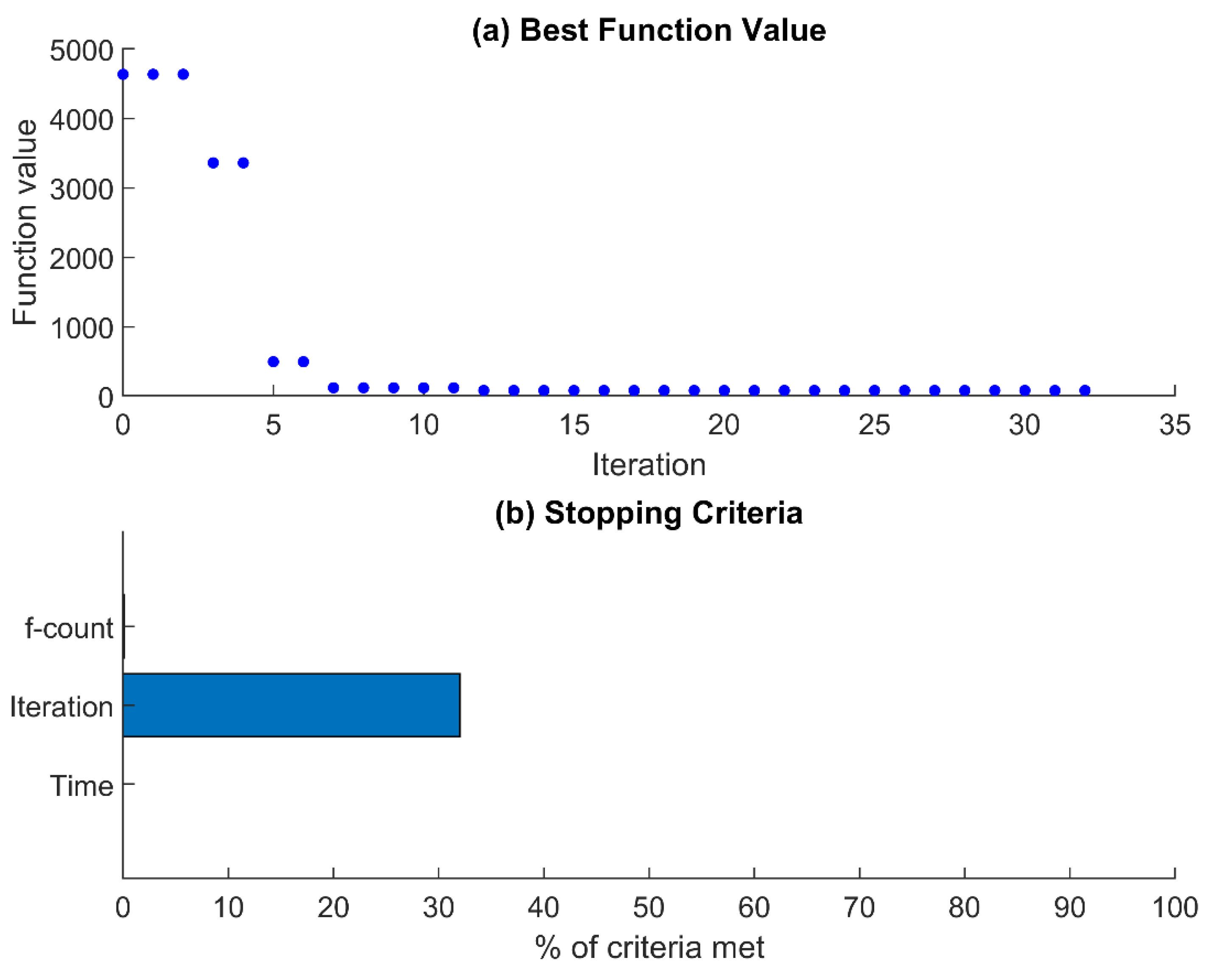

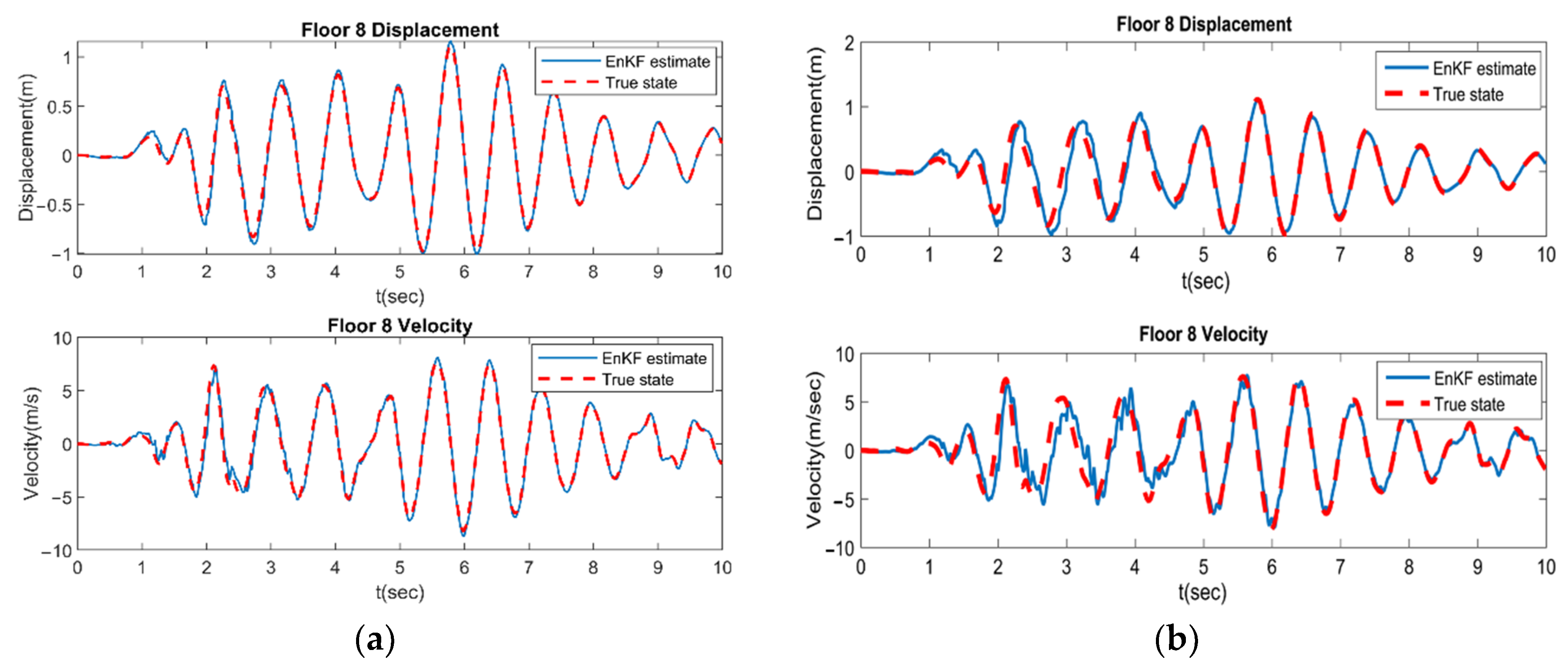
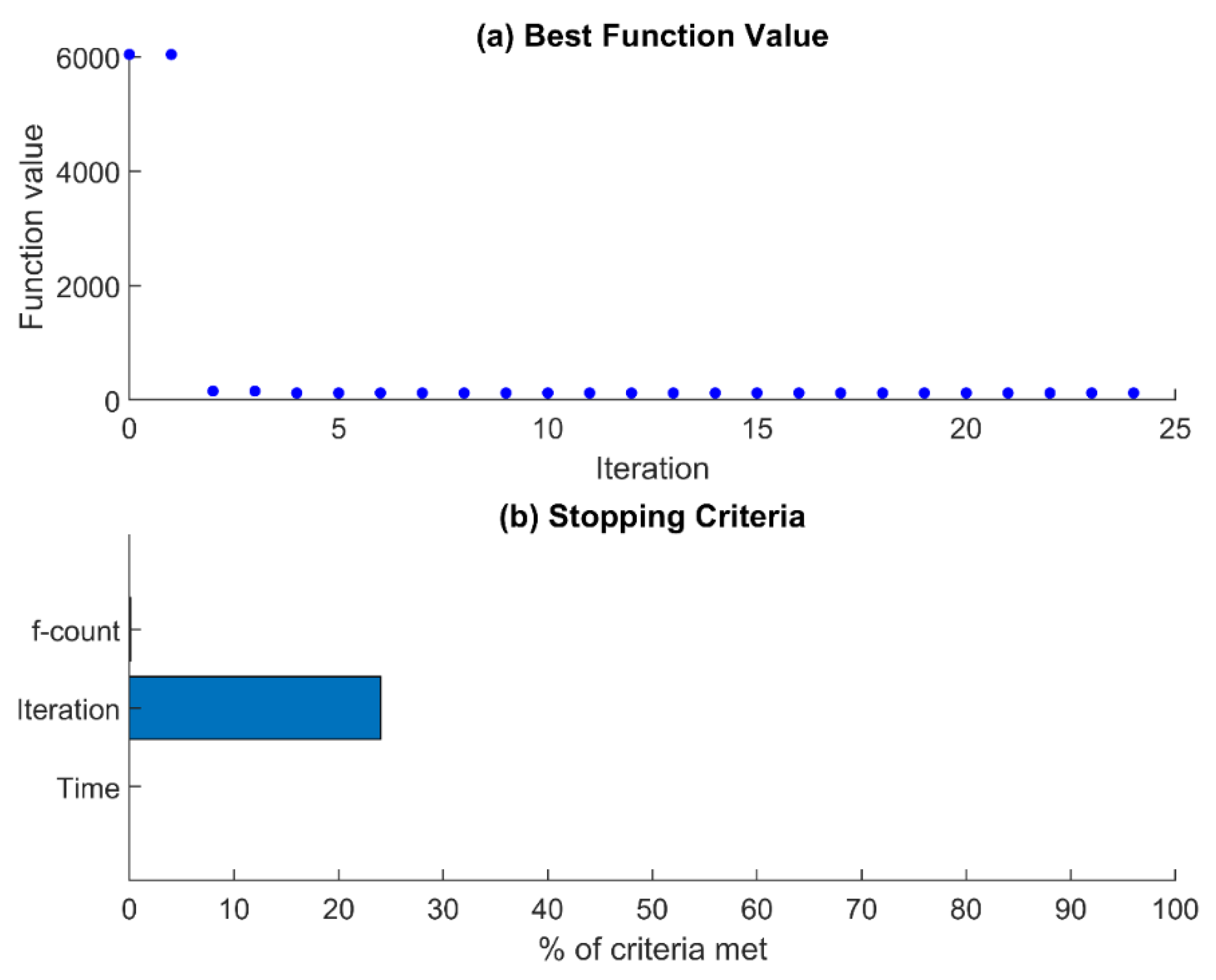
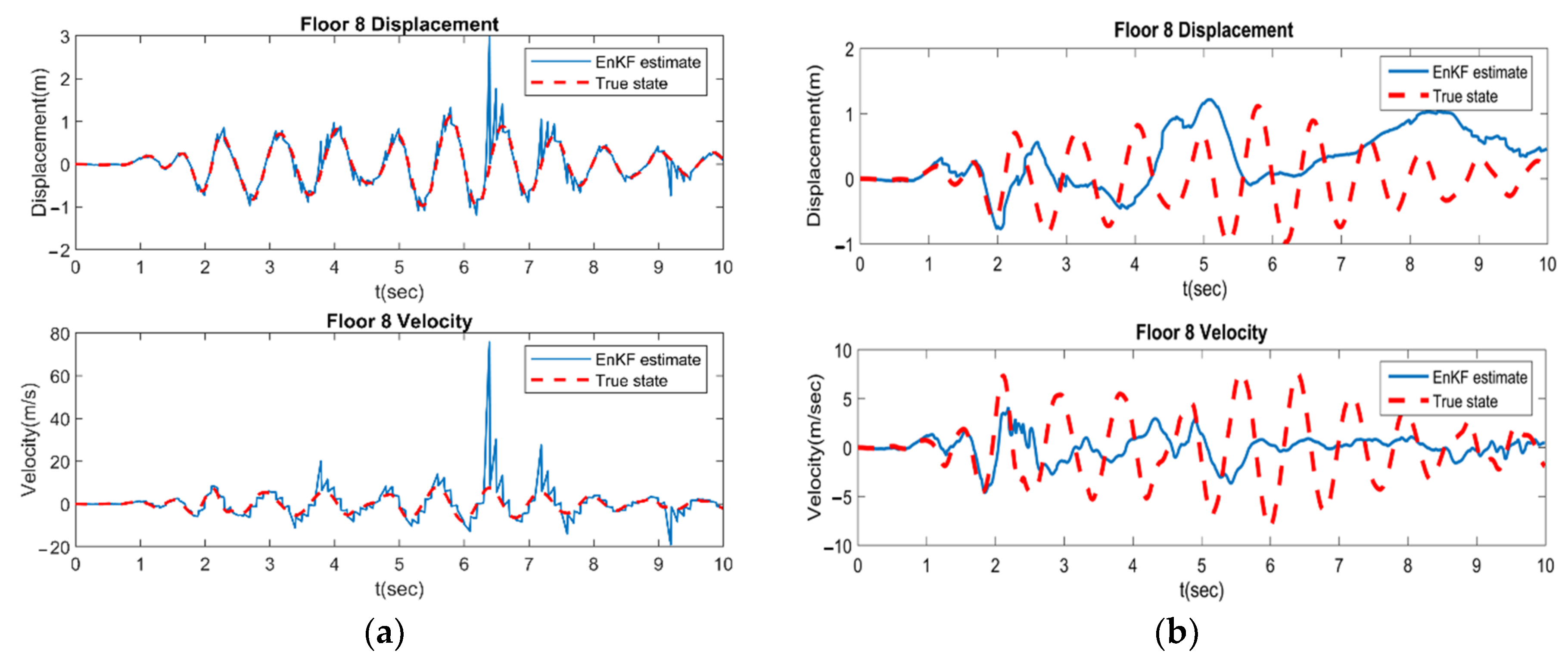
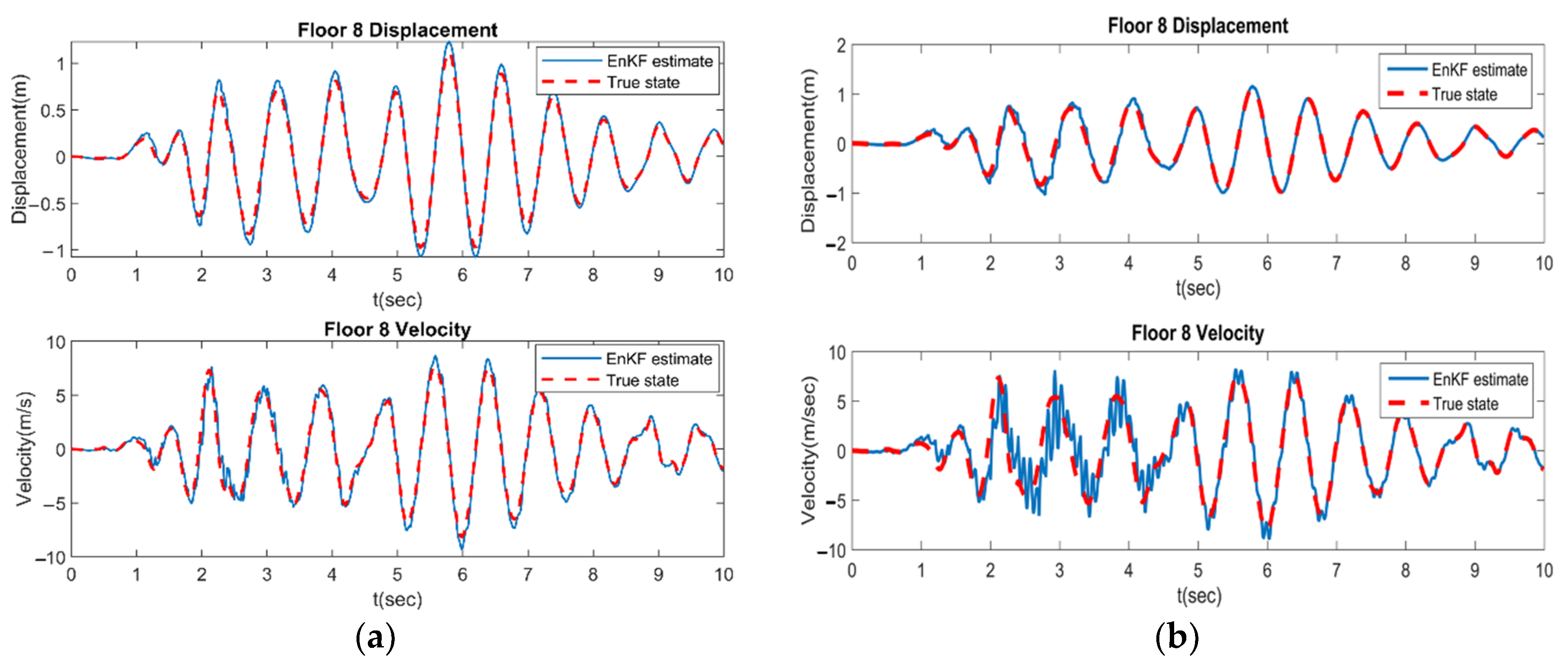

| Components | Multiplying | Related to |
|---|---|---|
| {ai} | The inter-story drift of floor i | the stiffness of floor i (directly) |
| {bi} | The cube of the inter-story drift of floor i | the stiffness of floor i (indirectly) |
| {ci} | The inter-story velocity of floor i | the damping of floor i (directly) |
| {di} | The product of the inter-story drift and the velocity of floor i | the damping and the stiffness of the floor i (indirectly) |
| Number of Sensors | Total Number of Combinations | Brute-Force Approach Optimal Results {Floors} | SA-EnKF Results {Floors} | GA-EnKF Results {Floors} |
|---|---|---|---|---|
| 2 | 45 | {1 10} | {3 10} | {1 10} |
| 3 | 120 | {1 7 10} | {3 6 10} | {1 7 10} |
Publisher’s Note: MDPI stays neutral with regard to jurisdictional claims in published maps and institutional affiliations. |
© 2022 by the authors. Licensee MDPI, Basel, Switzerland. This article is an open access article distributed under the terms and conditions of the Creative Commons Attribution (CC BY) license (https://creativecommons.org/licenses/by/4.0/).
Share and Cite
Nasr, D.; Dahr, R.E.; Assaad, J.; Khatib, J. Comparative Analysis between Genetic Algorithm and Simulated Annealing-Based Frameworks for Optimal Sensor Placement and Structural Health Monitoring Purposes. Buildings 2022, 12, 1383. https://doi.org/10.3390/buildings12091383
Nasr D, Dahr RE, Assaad J, Khatib J. Comparative Analysis between Genetic Algorithm and Simulated Annealing-Based Frameworks for Optimal Sensor Placement and Structural Health Monitoring Purposes. Buildings. 2022; 12(9):1383. https://doi.org/10.3390/buildings12091383
Chicago/Turabian StyleNasr, Dana, Reina El Dahr, Joseph Assaad, and Jamal Khatib. 2022. "Comparative Analysis between Genetic Algorithm and Simulated Annealing-Based Frameworks for Optimal Sensor Placement and Structural Health Monitoring Purposes" Buildings 12, no. 9: 1383. https://doi.org/10.3390/buildings12091383
APA StyleNasr, D., Dahr, R. E., Assaad, J., & Khatib, J. (2022). Comparative Analysis between Genetic Algorithm and Simulated Annealing-Based Frameworks for Optimal Sensor Placement and Structural Health Monitoring Purposes. Buildings, 12(9), 1383. https://doi.org/10.3390/buildings12091383







